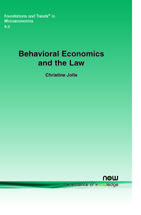Behavioral Economics and the Law
By Christine Jolls, Gordon Bradford Tweedy Professor of Law and Organization, Yale Law School, USA, christine.jolls@yale.edu
Abstract
This monograph describes and assesses the current state of behavioral law and economics. Law and economics had a critical (though underrecognized) early point of contact with behavioral economics through the foundational debate in both fields over the Coase theorem and the endowment effect. In law and economics today, both the endowment effect and other features of behavioral economics feature prominently and have been applied to many important legal questions.
Behavioral Economics and the Law
Behavioral Economics and the Law begins with the early evolution of behavioral economics both outside and within legal policy analysis and then describes the central role of behavioral economics in such analysis today. The "behavioral law and economics" of today is rooted in more traditional law and economics, so it is useful to start with an understanding of the field's jumping-off point. Behavioral law and economics has sought to bring the insights of behavioral economics to bear on many topics within the field of law and economics. Behavioral Economics and the Law describes a number of the central attributes and applications of behavioral law and economics to date. It does not embrace every area in which behavioral economics has become influential in legal policy in America and beyond, but it does seek to give a representative sample of the burgeoning modern field of behavioral law and economics. Section 1 begins with the early development and refinement of one of the pivotal insights of behavioral economics - that people frequently exhibit an endowment effect - both outside and within the field of behavioral law and economics. Section 2 offers a general overview of the features of human decision making that have informed modern behavioral law and economics. Section 3 provides a general typology of legal responses to bounded rationality, bounded willpower, and bounded self-interest. Sections 4 through 6 move from the general to the concrete, offering a range of illustrative applications of behavioral law and economics in the domains of bounded rationality, bounded willpower, and bounded self-interest respectively.
